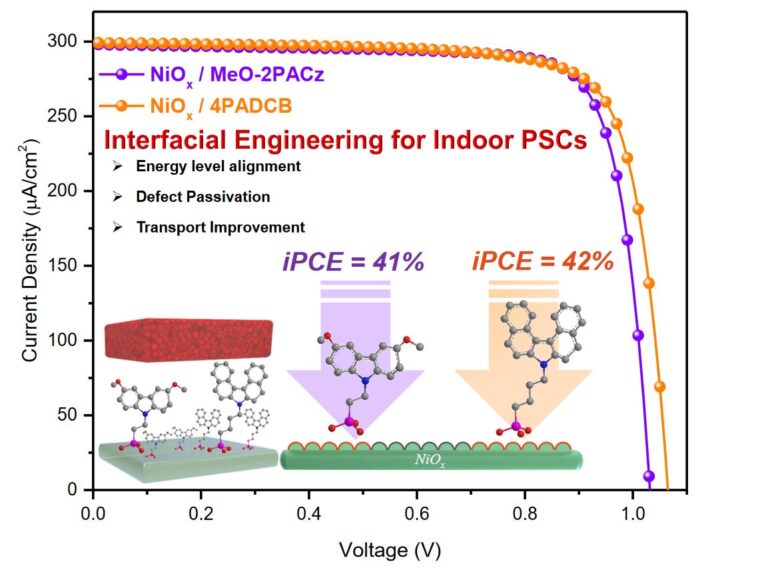Researchers in Taiwan have developed an efficient approach for carrier transport and defect passivation at the nickel oxide/perovskite interface in perovskite solar cells, enabling devices with efficiencies of 42% under indoor lighting conditions, and more than 20% under simulated sunlight .
Recent advances in the development of perovskite solar cells for indoor applications have resulted in indoor energy conversion efficiency of more than 40%, driven by improvements in both bulk and passivation of interfacial defects, according to a research team led by Taiwan’s Ming Chi University of Technology .
With this in mind, the group sought to further optimize this cell technology through the use of self-assembled monolayers (SAMs), which reportedly improve perovskite growth and optoelectronic properties. The study’s lead author, Chih-Ping Chen, said pv magazine that the cell achieved an indoor energy conversion efficiency of 42% under 3,000 K LED lighting at 1,000 lux.
“This breakthrough highlights the potential of our approach to further develop indoor perovskite solar cell (PSC) technologies, expanding their applicability in low-light environments,” said Chen. “We specifically focused on the passivation effects of four commonly used SAMs for the modification of nickel(II) oxide (NiOx) in inverted perovskite solar cells, where MeO-2PACz and 4PADCB appear to be particularly effective in modifying the hole-selective layer ( HSL), optimizing surface properties and improving energy level alignment.”
In particular, the research team investigated the effect of four SAMs with different linker lengths and terminal functional groups on critical NiOx/perovskite interfacial films, depositing them via spin-coating. The SAMs used were 2PACz, MeO-2PACz, 4PADCB and Me-4PACz.
The researchers analyzed the performance of the perovskite cells made with SAM-modified NiOx layers and wide bandgap perovskite layers based on Cs0.18FA0.82Pb(I0.8Br0.2)3, finding that they achieved an “impressive performance.” of more than 20%. energy conversion efficiency under simulated sunlight at an intensity of AM 1.5 G 100 mW/cm2.
They also found that the best performing MeO-2PACz and 4PADCB devices had efficiencies of 20.19% and 20.18%, respectively. This contrasts with the best performing reference cell which had an efficiency of 14.98%. They also noted improved open-circuit voltage and fill factor values for the target devices.
The target devices showed a “remarkable improvement” compared to the control device, which the researchers attributed to reduced non-radiative recombination and better carrier motion, indicating a reduction in defect density at the HSL/perovskite interface.
The cells are made with a substrate made of indium tin oxide (ITO), the NiOX film, SAMs, a perovskite absorber, an electron transport layer based on phenyl-C61-butyric acid methyl ester (PCBM), a bathocuproin (BCP) buffer layer and a silver (Ag) metal contact.
“Our strategy not only significantly improves fill factor values but also paves the way for NiOx-based PSCs for indoor light harvesting applications,” the researchers concluded.
The new cell architecture was described in “Achieving indoor efficiency above 42% in wide bandgap perovskite solar cells through optimized interfacial passivation and carrier transport”, which was recently published in Journal of Chemical Technology.
This content is copyrighted and may not be reused. If you would like to collaborate with us and reuse some of our content, please contact: editors@pv-magazine.com.


